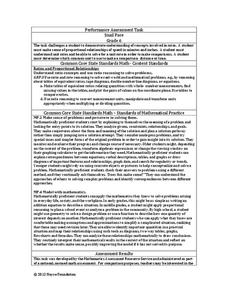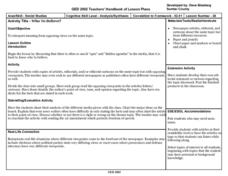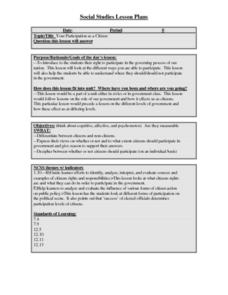Curated OER
Human Computer Game
Students view the "Parts of a Computer" Power Point presentation then they view the inside of a computer and break down each operating system and its job. They compare and contrast the difference between human and computer parts that...
Curated OER
It Takes a Community
Third graders examine their own city governments. They investigate the rights and responsibilities of individuals as well as government services in their town. Students invite members of the governing body to speak to the class.
Curated OER
Using Maps in the LCTL Classroom
Students review terms and prepositions of location and view a map to illustrate the meanings of the prepositions students are unfamiliar with. They play "Where am I?" game utilizing correct prepositions then they work with a partner to...
Curated OER
Statistics
In this statistics worksheet, students view 6 graphs to determine the correlation. Students then answer 4 questions that involve plotting data, determining a relationship, and making predictions.
Curated OER
The Roles of the President
Students explore presidential duties. In this executive branch lesson, students examine myths regarding the role of the President of the United States and discuss them. Students view a PowerPoint presentation that feature the President's...
Noyce Foundation
Snail Pace
Slow and steady wins the race? In the assessment task, scholars calculate the rates at which different snails travel in order to find the fastest snail. Hopefully, your class will move much more quickly in finishing the task!
Curated OER
What is Prejudice?
Students tell who Rosa Parks was and what she did to become famous and what state she did it in, and who Martin Luther King Jr. was, why he was important in history, and how we was connected with Rosa Parks.
Curated OER
State Your Position
Learners practice using a global positioning system. They discuss the use of celestial objects as navigation points and its problems. They list the advantages and disadvantages of GPS as well.
Curated OER
What do you know about your town?
Learners create a PowerPoint about the community they live in now and long ago. In this community lesson plan, students fill out graphic organizers about town events that have happened and create timelines as well.
Curated OER
Who To Believe?
Students interpret meaning from opposing views on the same topic, and discuss that there is often so much "spin" and "hidden agendas" in the media.
Curated OER
Declaration of Independence
Eighth graders explain the meaning of the Declaration of Independence. They view a political cartoon of the period, then do a writing assignment for homework. They write about how they would feel if the British were calling them traitors.
Curated OER
The Duties of Governments: Dix vs. Pierce
Students examine the role of Dorothea Dix on behalf of people with disabilities. They discuss President Pierce's veto of legislation she helped create. They address the rights and responsibilities of citizen's and the role of government.
Curated OER
Sewing Unit (Textiles)
Get out that sewing machine it's time for a textile project. The class learns how to use a sewing machine, read a pattern, and create a simple article of clothing. They identify the sewing machine parts, use an iron, and think about...
Curated OER
Index Card Jigsaw
Students explore accomplishments of historical figures. Through participation in a hands-on activity, teams of students match names, quotes, views and political party affiliation to the correct picture. They create a chart from the...
Curated OER
ndirect Measurement Technique: Using Trigonometric Ratios
Ninth graders find the height of an object that would be difficult or impossible to measure directly. They construct and use a Clinometer to measure the angle of elevation (or depression). Students create a sketch of the measurement...
Curated OER
Freedom on My Mind: A Marginalized Voice in the Segregated South
High schoolers analyze the film, "Freedom on My Mind." They view the film and discuss its points in small groups. They create a fictional southern state reflecting segregation in the 1960's. They present their states to the class.
Curated OER
Introduce /O/
Students demonstrate the letter sound, "o." For this sound fluency lesson, students view a letter card of the letter "o" and practice the letter sound by repeating it several times. Students identify the sounds of the letters written on...
Curated OER
Number Subsets: Winning the Number Game
Eighth graders review their examineing about numbers and number systems through playing the Number Game. They create a list of numbers and based upon the characteristics and properties of the numbers they earn points.
Curated OER
Your Participation as a Citizen
Students investigate their right to participate in the governing process of our nation. They look ast the different ways they are able to participate. They define citizenship, and decipher between whether or not citizens should...
Curated OER
Old Mother Twitchett
Students view and discuss the a-rhyme-a-week poster"Old Mother Twitchett." They review the vocabulary from the chart and then focus on the pictures. Each student then chants the rhyme as they are taught the words to the riddle rhyme.
Curated OER
Introduction to Computers and Understanding Commands
Students conjugate the simple past and present tenses of various verbs, and respond to computer commands. They view computer flashcards, and complete a verb conjugation worksheet.
Curated OER
Anti-social Behavior - A Topical Lesson From Learn.co.uk
Students discuss issues of crime, punishment, respect and responsibility,
and explore arguments about causes of crime and possible solutions, and write persuasive essays sharing their views.
Curated OER
Illustration of the Destruction of a Rebel Salt Factory on the Florida Coast
Learners view an illustration of the destruction of a salt factory. They analyze the photograph to learn more about the salt works. Students discuss what they have learned.
Curated OER
"Be the Kiwi" - Bible
Young scholars compare and contrast the English version to the Maori version of the Treaty of Waitangi. In this diversity lesson, students discuss similarities and differences in the two versions of the treaty. Young scholars...

























